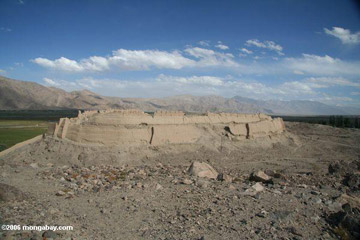Climate change fueled ancient wars in China
Climate change fueled ancient wars in China
mongabay.com
July 10, 2007
A new study ties past climate change to warfare in ancient China.
Writing in Human Ecology, David Zhang from the University of Hong Kong and colleagues show that warfare frequency in eastern China between 1000 and 1911 A.D. was significantly correlated with temperature oscillations. Comparing 899 wars during that period to historical temperature data, the researchers found that warfare peaked during cold phases.
“Temperature fluctuations directly impact agriculture and horticulture and, in societies with limited technology such as pre-industrial China, cooling temperatures hugely impact the availability of crops and herds,” explained a statement from Springer, publisher of the journal Human Ecology. “In times of such ecological stress, warfare could be the ultimate means of redistributing resources.”
 Tashkorgan, an ancient fortress in far western China. |
“Oscillations of agricultural production brought by long-term climate change… drove China’s historical war-peace cycles,” wrote the authors, who recommend that historians consider climate change when examining the reasons behind historical conflicts.
Zhang says that shortages of essential resources–including fresh water, agricultural land, energy sources and minerals–may spawn wars in the future.
The Human Ecology comes just weeks after U.N. Secretary General Ban Ki-moon said that the unrest in Darfur, Sudan was triggered by global climate change and that similar conflicts may be on the horizon.
Zhang DD, Zhang J, Lee HF, He Y (2007). Climate change and war frequency in eastern China over the last millennium. Human Ecology; (DOI 10.1007/s10745-007-9115-8)